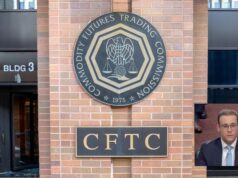In a move that could reshape stablecoin adoption in Asia, Circle has announced a strategic partnership with Ant Group, the fintech powerhouse backed by Jack Ma. The collaboration will bring USDC into Ant’s blockchain infrastructure and aims to support both cross-border payments and broader financial inclusion in the region. This is more than a technical alliance. It’s a calculated offshore stablecoin strategy by a leading Chinese tech firm to remain competitive in the evolving world of regulated digital currencies.
The Partnership Explained
This Ant Group – USDC integration will see Circle’s dollar-pegged stablecoin embedded into Ant’s enterprise-facing blockchain systems. The move lays the groundwork for enterprise blockchain finance use cases. These include digital trade settlements, on-chain remittance tools, and fintech app development.
Unlike speculative crypto experiments, this Circle stablecoin partnership is grounded in solving practical financial inefficiencies. It promises faster settlement, reduced costs, and increased accessibility for small businesses. The rollout will also enhance blockchain use in cross-border payments, enabling seamless financial interactions across borders.
>>> Read more: Deutsche Bank Stablecoin Plans Linked to Ant Deal
Offshore Strategy: Navigating Around Mainland China’s Crypto Ban
While China’s crypto regulation remains firmly prohibitive, its tech giants are innovating abroad. Ant Group, JD.com, and other firms are actively building digital asset services in jurisdictions like Hong Kong and Singapore. These efforts reflect a larger strategy for stablecoin use in offshore markets, where regulatory clarity is more achievable.
Ant Group is reportedly pursuing a stablecoin license in Hong Kong, giving it a regulated foothold in one of Asia’s most progressive digital finance hubs. This strategy positions Ant as a global player without clashing directly with Beijing’s domestic restrictions, a shrewd geopolitical move.
USDC’s Rising Influence in Asia
This collaboration also expands Circle in Asia, reinforcing USDC’s reputation as the stablecoin of choice for regulated, enterprise-grade use. Though USDT dominates speculative markets, USDC’s integration into major tech infrastructure could shift regional preferences, particularly among institutions.
This is not merely about adoption; it’s about digital dollar influence. With USDC gaining traction in Asia, digital dollar adoption could accelerate in major financial centers. These include Tokyo, Seoul, and Dubai, where regulatory support is rising.
The Inclusion Angle: Why This Move Matters for Emerging Markets
Beyond the regulatory game, this partnership signals a push toward blockchain-driven financial inclusion. Today, millions across Southeast Asia, Latin America, and Africa lack access to stable financial services. With Ant Group’s broad reach and Circle’s technology, the two companies, together, could serve these populations in the future.
By embedding USDC into user-friendly platforms, the alliance enables faster and cheaper remittance with stablecoins, bypassing traditional banking friction. It’s a clear example of financial inclusion via blockchain, offering economic access to those historically left out of the system.
What’s Next: Regulation, Adoption, and Geopolitical Undercurrents
As Ant Group awaits approval for its Hong Kong stablecoin license, the world watches for ripple effects. Will this partnership inspire similar alliances between U.S. fintechs and Asia-based tech titans? Can it bridge the divide between the U.S. and Chinese regulatory spheres?
This evolution of enterprise blockchain finance also raises the stakes for governments and multinational corporations alike. As stablecoins like USDC gain ground through trusted brands, new standards may emerge for transparent, compliant digital currency infrastructure.
>>> Read more: Circle OKX Partnership Launches Zero-Fee USDC Conversions
This Ant Group USDC partnership blends the best of two fintech worlds: enterprise-grade innovation and regulatory foresight. Whether seen as an offshore stablecoin strategy, a compliance-driven play, or a tool for economic inclusion, the initiative marks a turning point in Asia’s blockchain finance trajectory.
USDC integration is now underway at the highest levels of Asian fintech. The era of cautious experimentation may be ending, and the age of digital dollar adoption might just be beginning.
Readers’ frequently asked questions
Why is Ant Group partnering with Circle instead of launching its own stablecoin?
Ant Group is taking a regulatory-first approach by aligning with Circle, a U.S.-regulated issuer. This strategy allows Ant to deploy a widely recognized, compliant stablecoin without waiting for domestic Chinese approvals or launching an untested proprietary asset.
How does Ant Group’s USDC move stay compliant with China’s crypto ban?
Ant Group is leveraging offshore regulatory jurisdictions like Hong Kong and Singapore to legally engage in digital asset innovation. By integrating USDC outside mainland China and through a licensed partner like Circle, Ant avoids direct conflict with Beijing’s domestic crypto policies while still advancing blockchain capabilities abroad.
How does this move affect USDC’s competition with USDT in Asia?
While USDT dominates retail trading, USDC is positioning itself as the preferred stablecoin for institutions and regulated ecosystems. The Ant Group deal strengthens USDC’s reputation in compliance-driven markets and may tip the balance for enterprise adoption.
What Is In It For You? Action items you might want to consider
Monitor Ant Group USDC rollouts in regulated jurisdictions
If you work in blockchain infrastructure or cross-border fintech, watch how USDC is integrated into Ant Group’s international platforms. Pay close attention to pilot programs in Hong Kong or Southeast Asia, where early adoption may shape regional enterprise standards.
Evaluate stablecoin positioning strategies in Asia-Pacific
Crypto founders, treasury teams, and digital asset investors should reassess the role of USDC versus USDT in Asia. Ant Group’s alignment with Circle could shift regulatory favor toward compliant stablecoins across trade corridors and fintech services.
Track global partnerships between Asian tech firms and U.S. stablecoin issuers
This deal might signal a new pattern: Chinese tech companies using U.S.-compliant stablecoins to expand abroad. Hence, enterprises should track similar alliances involving JD.com, Tencent, or global payments players entering the stablecoin space.











[…] >>> Read more: Ant Group Partners with Circle to Integrate USDC Globally […]